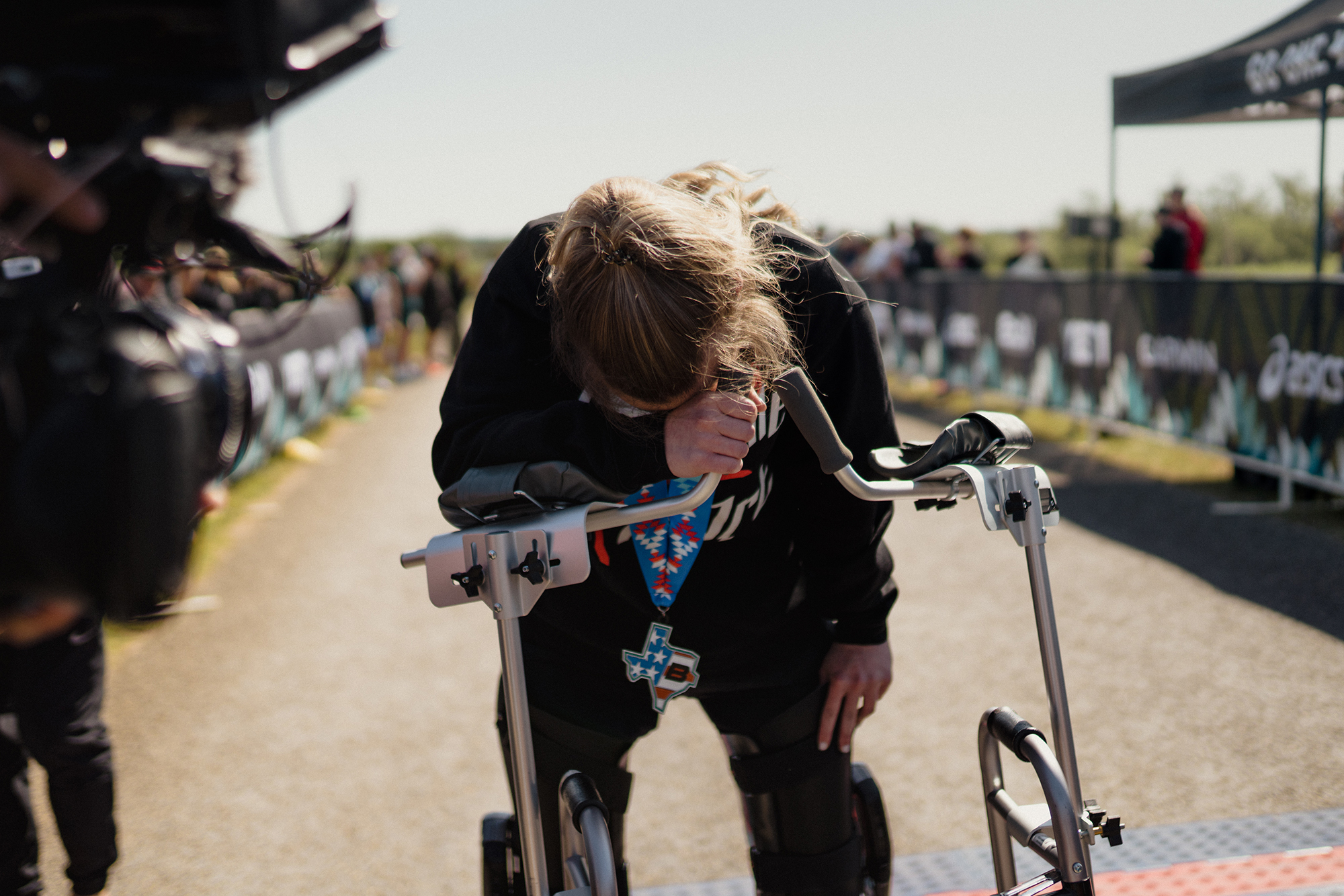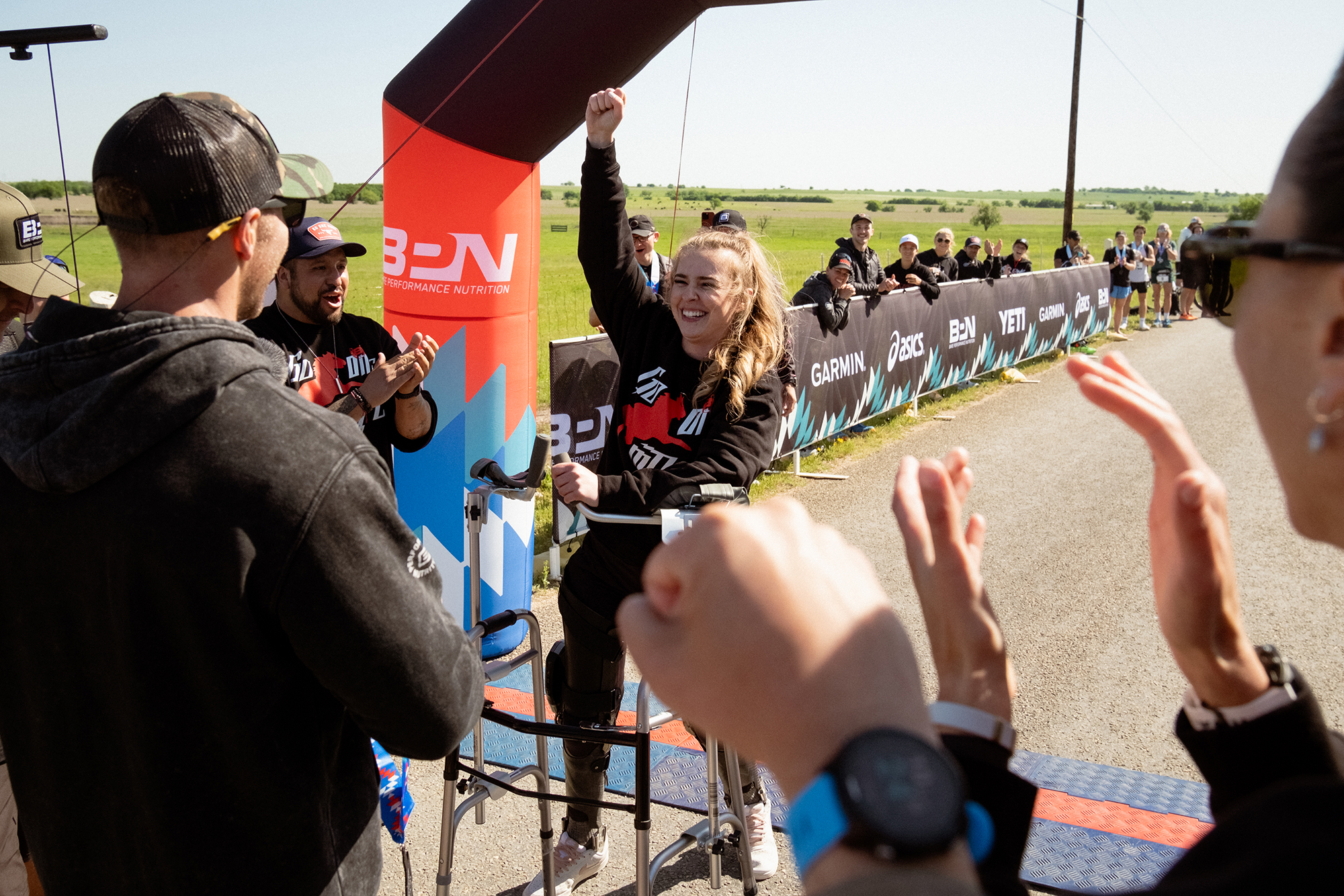I Thought I Would Never Walk Again, but Thanks to Bionic Legs—And My Own Resilience—I Just Completed the Final Mile of a Marathon
Paralyzed from the waist down at age 19, Hannah Hutzley’s diagnosis has not kept her from going the distance.
At 4 a.m. on a ranch in central Texas, the only light shining came from the stars, and two headlamps. Hannah Hutzley, wearing a pair of bionic legs, focused on putting one foot in front of the other. All she could see was contained in the three-foot halo of light emitted by her headlamp and the lamp of her companion, Tony Reyes. The rest was pitch black. But on the road to walking a mile—her first mile in six years—that light was enough to illuminate her path as she took it: one step at a time.
In 2017, after a car accident, doctors told a then 19-year-old Hutzley she would never walk again. She had sustained a severe spinal cord injury, paralyzing her from the waist down, which left no control or feeling in her leg muscles except for a small amount of strength in her hip flexors. Hutzley recalls thinking during her first night in the hospital that she would never be happy again.
Years of physical therapy followed. She learned how to transfer herself out of bed and into her wheelchair. She figured out how to put on socks. And while as a high school and college soccer player, she had always spent time in the gym focusing on her lower body, she began to train her upper body strength and started participating in Spartan Races. Along the way, she shared her life on Instagram with candor, humor, and intense vulnerability.
People began to take notice. Today, she has nearly 100,000 Instagram followers. In 2022, Bare Performance Nutrition (BPN) made her an athlete ambassador. Becoming a sponsored athlete post-accident was “beyond my wildest dreams,” Hutzley says. “I was like, 'Are you sure you called the right person?'”
***
In the almost total darkness, the mood was light. Hutzley walked with Reyes, her friend and BPN’s media director, who stabilized the walker Hutzley was using for support; it had been affixed with all-terrain tires to handle the dirt and gravel that made up the route. The headlamps attracted enormous Texas beetles, flying in Hutzley’s and Reyes’s faces. All they could do was laugh, and as they walked, they sang the refrain “I would walk 500 miles” over and over again. Every 20 steps or so, Hutzley would pause, before pushing forward once more.
Hutzley and Reyes were walking on the last mile of the BPN-sponsored Go One More Marathon. Their route started as a gradual uphill dirt road with a sharper incline halfway through. Then it leveled out until the end, where another steep incline made up the last tenth of a mile to the finish line.
At around just 0.2 or 0.3 miles into their one-mile trek, Hutzley’s right leg started to falter. She took breaks to catch her breath and ease the fatigue she was feeling in her hip flexors and the tingling in her feet, but kept going, joking, “This is a first—my legs hurt!”
Hutzley made it to the top of the incline, her halfway point, around 7 a.m. as the official race began and the sun rose.
***
Hutzley says there was always a part of her that questioned the finality of her diagnosis.
“It became very apparent very quickly that [the doctors] were right, that I alone would never walk again,” Hutzley says. “But just on the back burner though, I just always felt like that wasn't the final say.”
A possibility presented itself in 2021. A member of her treatment team told Hutzley about a product called the C-Brace by prosthetics, orthotics, and exoskeleton maker Ottobock. It is a leg brace that contains smart hydraulics and a computerized knee joint that together allow for the leg to swing, the knee to bend and then to straighten, in time with and support of a person’s gait. It requires the wearer to have enough movement in their leg (or legs) to propel the brace forward, but it also allows for the person to bear weight on their legs, helping them bend their knees and make a walking motion.
Ottobock first developed the C-Brace for people with unilateral (single leg) paralysis because smart prosthetics are still such an up and coming area. “Nobody had experience in this field and we started conservatively,” says Ottobock global product manager Christof Küspert. Providing movement assistance for one leg is one challenge, but bearing the entirety of a person’s weight on a robotic structure is a whole other ball game. Hutzley was even told by her physio that the C-Brace wasn’t necessarily for people like her with bipedal paralysis—but they were both interested in what it could do. Hutzley went through a year of trying to qualify for the braces through insurance, and finally got them in June 2022.
Today, Hutzley is one of a small number of people with bipedal paralysis who are using the braces, which she does with the assistance of a walker since she wouldn’t be able to bear her weight and balance on the legs alone.
“I personally love to see the growing number of bilateral cases, who highly depend on safe devices to give back more freedom of mobility,” says Küspert
Hutzley’s progress in learning to use the brace to walk was slow. It took weeks to go from sitting to standing while wearing the braces. But when she did, Hutzley says the experience of bearing her weight on her legs “felt like coming home.”
As she began to take her first steps, Hutzley realized she wanted to do “something big.” It was taking her hours to walk around 200 steps, but at the suggestion of one of her physical therapists, an idea got lodged in her mind: one mile. She decided she wanted to walk a mile in the BPN “Go One More” race in April of the following year.
Reyes had witnessed Hutzley’s early attempts with the C-Brace. So when he got the call that she wanted to do a mile, he felt conflicted. He knew that training would be intense, and that completing the challenge was not a given. The endeavor could open Hutzley up to both injury and disappointment. But that feeling quickly gave way to supporting her determination.
“I know Hannah knows herself, and if she believes that she can do this, then she will absolutely do this.
—Tony Reyes
“As her friend, and as someone who cares about her, I'm worried for her health and her safety and all those things,” Reyes says. “But also in the back of my mind, I'm like, I know Hannah knows herself, and if she believes that she can do this, then she will absolutely do this.” On the phone when Hutzley proposed the idea, he responded simply, “Let’s go.”
For the next 10 months, Hutzley trained. She spent three to four hours using the braces in physical therapy each week, and also worked on strengthening her hip flexors by crawling at the gym. In February, she feared a foot injury would derail her plans for the April mile. But with the okays of her doctors, she wrapped her foot up in bubble wrap and kept crawling during the month her foot needed to recover enough to bear weight again.
When Reyes visited Hutzley during a training session on a track, he knew it was game on for the mile. “I was blown away by how much she'd progressed,” Reyes says. “She was hauling ass down that track. I was just completely flooded with emotion.”
In the days before the race, Hutzley and Reyes trekked out to the central Texas private ranch where the marathon would take place. The course was about a 6.5 mile out-and-back route, where some people would be running a total of 13.1 miles for the half marathon, and some would do that twice for a full marathon. Either way, everybody would be finishing at the starting line, so that’s where Hutzley and Reyes wanted to finish, too, meaning they would walk the last mile of the course.
The only issue? The hilliness of that mile, and the fact that they had not trained for walking on loose gravel and dirt. Still, Hutzley felt confident using her walker with the special tires, so they soldiered on.
"At 23, I took my second first steps."
—Hannah Hutzley
The night before the race, Hutzley addressed the athletes who’d come to a celebration dinner. She began her speech by saying, “At 23, I took my second first steps.” Later, as she climbed into bed and set her alarm for 1:30 a.m., she knew that what lay ahead would be a challenge.
“I'm gonna have to work really hard to earn this,” Hutzley says. “But I think that's how you should feel.”
***
As they got closer to the finish line, the quiet and darkness of the early morning gave way to a crisp sunshine, cheers, and blasting music.
The racers began to appear. Clumps of people (who had heard her speak the previous night) began to run towards and past Hutzley, with the vast majority of them urging her on, many stopping to give her a hug, tell her how much she meant to them, and encouraging her to keep going.
Hutzley needed it. Her right leg was barely clearing the ground, and pain coursed through her whole body. But the community buoyed her.
“They were all saying my name,” Hutzley says. “Strangers saying, ‘Keep going Hannah, you got this Hannah, don't give up, Hannah.’”
With 0.9 miles of the route behind them, the course curved, the gravel turned into pavement, and—up a hill—the finish line came into sight. Though Hutzley had been stopping to rest every 20 to 30 steps, Reyes told her, “We are gonna stop one time, and then we're not stopping until you cross the finish line.”
As Hutzley got closer, race organizers came up and asked what music she wanted to come home to. Reyes suggested nothing, no music; that way they’d just hear the crowd and community cheering Hutzley on.
For the final steps before the finish line, Reyes walked away, so Hutzley could cross it standing on her own. Every part of her body was on fire—even in her feet, something she hadn’t experienced in years. But she looked around, took it all in, and knew the pain was worth it.
“I'm almost there, I can push through this,” she recalls thinking. “This is a very temporary feeling for this, one of the greatest moments of my life. That bargain is worth it every single time.”
Hutzley had to get up and over one final bump to cross the finish line. She only really had strength left in her left leg at that point, but she was relishing every moment.
“I just had the biggest smile,” Hutzley says. “I had just taken it all in, and then I'm like trying to move that walker, trying to get my foot to clear. And then it just, it just happens. It's awesome. It's awesome.”
***
The next morning, Hutzley struggled to get out of bed. Literally. Transferring to her wheelchair was not the same in a body that was “totally zapped” from exertion.
And it made her realize something about her legs, her body, and herself. From scrutinizing her body in the mirror while trying on leggings at Target before her accident, to adapting to life in a wheelchair, to struggling with the C-Brace, Hutzley had long felt anger and alienation from her body. But pushing herself as hard and as far as she could go helped her see how much her body was still doing for her every day. Only when her hip flexors were so sore and tired the morning after the race that she no longer had access to them did she put together that her legs played a part in getting her out of bed and into her chair every morning. The remaining strength in her legs—along with her new newly muscular upper body and core—were still keeping her mobile and active, even if she didn’t realize it or appreciate it on other mornings.
“The fact that I get to say that my legs are sore, that they don't wanna move at all, that is so cool to me,” Hutzley says. “I love that, and I love feeling proud of my body for having every excuse in the book to not do something like this, and doing it anyway.”






